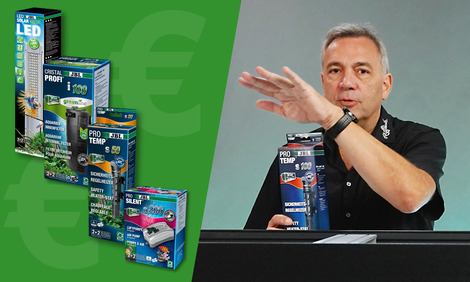At the moment we’re hearing from the internet, from technical articles and from TV how we can save enormous amounts of electricity. They basically advise us not to use the dryer so often and to dry the laundry on the clothesline.
And it’s true, a dryer consumes about €160 in electricity costs per year if it is not the latest model. But it also removes the need to iron the laundry, so you save more electricity by not ironing than the dryer consumes!
What does this have to do with aquaristics?
A lot, because we aquarists could also save on the amount of light, for example, but then be forced to buy new plants more often. These plants have to be produced and transported. It’s a false economy! Would it make a difference if we dimmed our LEDs and avoided operating them at full power?
Yes, it really would. In many aquariums, the fluorescent tubes have sensibly been replaced by LEDs. This replacement was the most important step towards saving energy! Since LEDs now provide much more light than tubes, it can be quite OK not to use the full output, but to reduce it by a few dimming levels. A T5 lamp provides about 1400 lux, an LED of the same length about 3-4 times that. There is a lot of talk on the internet about unplugging power supplies or devices when the appliance connected to them is not switched on (e.g. mobile phones or microwave ovens). This also applies to power supplies for LED lighting. But: Almost all aquarium lighting is timer, or light control computer, operated and these turn off the current, even if it’s only 0.5 to 1 watt. It is much more effective to place the lighting (in winter) under a cover. An open aquarium is only a good idea in summer to dissipate heat and thus save more energy, as cooling is not needed. A cover saves much more energy than a heat-insulating enclosure of the aquarium on the side walls and the back wall. A further covering of the front pane is yet to be tested.
Dear aquarists: Please don’t place the warming ballasts of the LEDs INSIDE the cover. These ballasts are not waterproof and there is a lot of condensation in the cover, especially in the morning.
Finally, a word about filters
It is really worth taking a look at the wattages specified. If you have a 300-litre aquarium, for example, you will find suitable external filters with 24 W, 18 W and from JBL with only 11 W power consumption. By the way, it does not save any electricity to regulate the filter down at the outlet. The power consumption remains the same. And the filter should not be switched off at night either. We are just mentioning this to be on the safe side, because the idea repeatedly comes up.
Don’t forget that aquariums up to 200 litres are much more economical than keeping a cat or dog.
